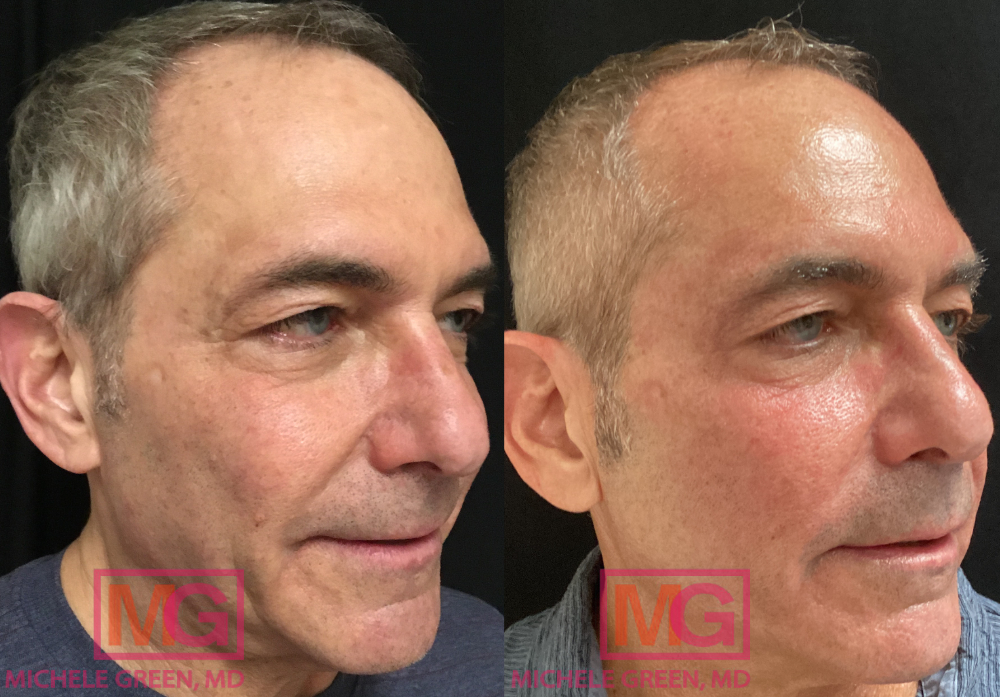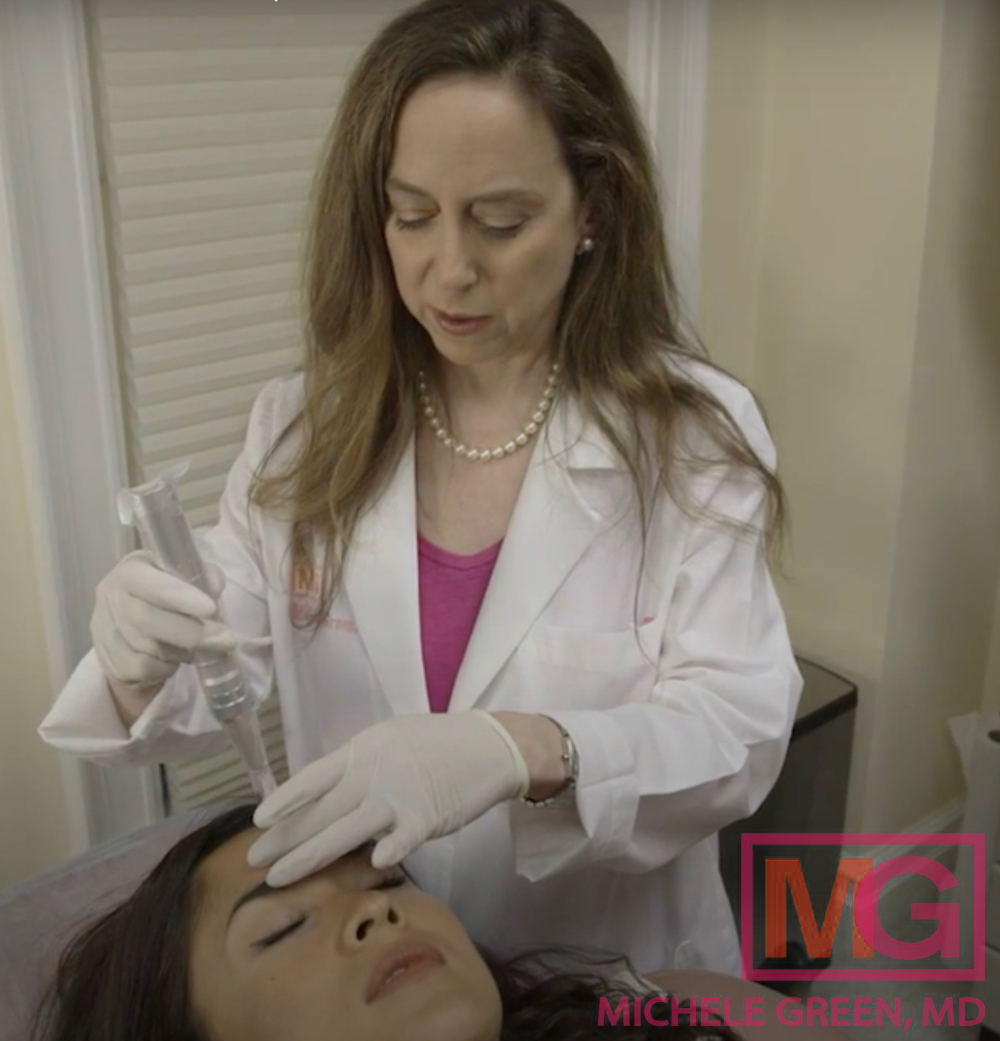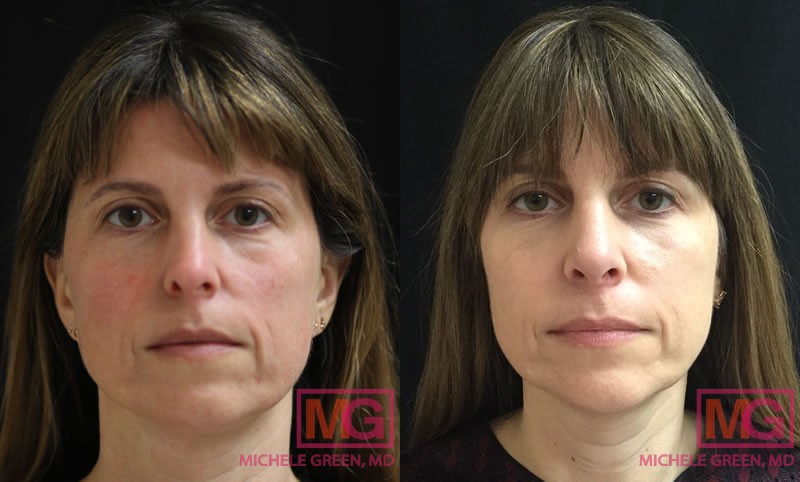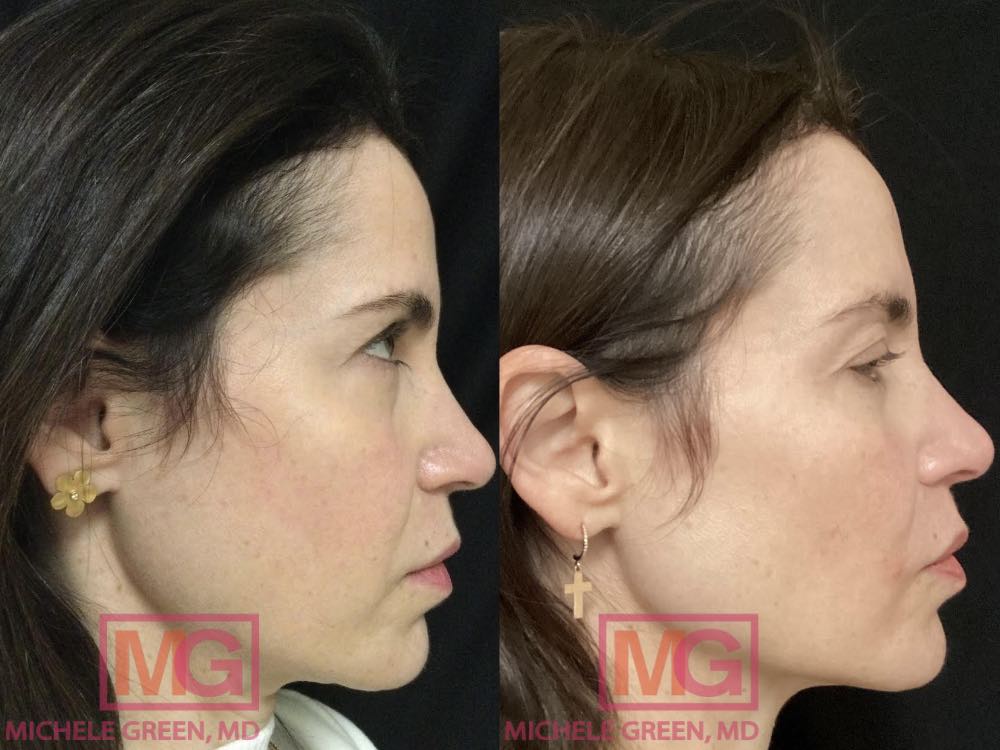Thermage vs. Microneedling
As we get older, the levels of the skin’s structural proteins, collagen and elastin, decrease. This decrease in structure can lead to skin becoming less firm and other signs of aging, like wrinkles and fine lines, becoming more noticeable. Reduced collagen production can contribute to signs of aging in various body areas, such as the lower face, jawline, jowls, eyes, neck, decolletage, arms, legs, abdomen, buttocks, and thighs. Loose skin on the face and body often leads people to seek anti-aging skin-tightening treatments. Many individuals mistakenly believe they need a surgical facelift performed by a plastic surgeon to combat these signs of aging. However, non-invasive skin-tightening procedures like Thermage and Microneedling provide a non-surgical solution that reduces skin laxity for a tighter and more youthful appearance. These procedures, available at the New York City dermatology office of board-certified dermatologist Dr. Michele Green, are safe and effective non-invasive treatment options for your anti-aging journey.
Thermage and Microneedling, both FDA-approved skin rejuvenation treatments, are non-surgical treatments that work by stimulating collagen production. Thermage uses radiofrequency energy to achieve this, tightening the skin and reducing cellulite and crepey skin. Microneedling, on the other hand, uses tiny needles to create numerous micro-injuries, which stimulate the natural healing process to create collagen and correct signs of aging, including uneven skin texture and tone and acne scars. Both treatments rejuvenate the skin from within the dermis, the middle layer of the skin. Both Thermage and Microneedling provide patients with long-lasting results with minimal downtime and no risk of significant side effects. To determine which treatment option is best for you, schedule your initial consultation with Dr. Green, who will generate the individualized treatment plan to suit your needs best.
Experienced board-certified dermatologist Dr. Michele Green has been masterfully treating patients in her Upper East Side New York City dermatology office for more than 25 years. An expert in a wide range of cosmetic and medical treatments, including Thermage, Botox, dermal fillers, chemical peels, Microneedling, laser treatments, and more, Dr. Green is well-known for creating unique treatment plans for each patient. Frequently recognized for high patient satisfaction, Dr. Green has been voted one of New York City’s best dermatologists by publications such as Castle Connolly, New York Magazine, and Super Doctors.
What is Thermage?
Thermage is an FDA-approved, non-invasive skin-tightening laser that uses radiofrequency energy to increase natural collagen production and tighten the skin. The RF energy penetrates the deeper layers of the skin, heating it and causing the collagen fibers in the skin to contract. The skin then starts producing new collagen, reducing the appearance of fine lines and wrinkles on the face and body, eliminating hooding in the eye area, improving the contour of the jawline and the appearance of a double chin, reducing the appearance of cellulite on the body, and tightening the skin for a smooth, firm, youthful look. Thermage is highly effective for use on larger body areas, including the thighs, buttocks, abdomen, and arms. The Thermage treatment has evolved, and the Thermage FLX is the latest generation of Thermage devices. Thermage FLX is the fourth-generation Thermage applicator with AccuREP technology to improve precision through real-time adjustments, provide optimal radiofrequency energy delivery, and improve patient comfort during the procedure. With a 4cm tip, the Thermage FLX applicator allows for more surface area coverage, increasing treatment speed by 25%. The treatment provides excellent skin tightening results in a single treatment session, and Thermage results can last 1-2 years post-treatment, though Dr. Green recommends receiving a touch-up annually.
What is Microneedling?
Microneedling, a versatile skin rejuvenation treatment, addresses many skin concerns. It can help with skin laxity, acne scars, fine lines, stretch marks, large pores, and hyperpigmentation. The procedure is minimally invasive with few potential side effects and is safe and effective for patients of all skin types and tones. A healthcare provider will use the Microneedling device across the desired treatment area. With its tiny needles and adjustable depth, this device allows for greater precision and control when treating different areas of the face and body. The ‘micro-injuries’ it creates stimulate the skin’s natural healing response to produce new collagen and elastin, resulting in a smoother, firmer skin texture, even skin tone, and enhanced radiance. To further enhance the treatment, Microneedling can be combined with radiofrequency energy, platelet-rich plasma (PRP), or depigmentation serum. With multiple customization options, the Microneedling treatment can target multiple skin concerns with minimal downtime.
Radiofrequency Microneedling, like traditional Microneedling, is a safe and effective skin rejuvenation treatment. It has minimal downtime and few potential side effects. Dr. Green offers the Vivace radiofrequency Microneedling treatment at her private dermatology office in NYC. This treatment uses a robotic motor to deliver precise, controlled pulses and gold-tipped, insulated micro-needles. Radiofrequency Microneedling treatments like Vivace are designed to reverse sun damage and other signs of aging by stimulating collagen production in different layers of the skin, resulting in a more youthful complexion.
PRP stands for platelet-rich plasma, a serum rich in growth factors that enhance the rejuvenation effects of Microneedling. PRP is collected from a patient’s blood sample, and the nutrient-rich plasma is isolated. The PRP is used as a topical serum during Microneedling. PRP promotes further regeneration at the cellular level to rejuvenate the skin. After the Microneedling procedure, patients are advised not to cleanse the skin in the treatment area for 24 hours to maximize the effects of the PRP and allow it to be fully absorbed.
Microneedling treatment with depigmenting serum is safe and effective for removing dark spots and achieving a more even-toned complexion. Dr. Michele Green uses a unique blend of powerful yet gentle skin-brightening agents in the depigmenting serum to counteract melanocyte activity in the skin. The result is an even-toned complexion with a noticeable reduction in hyperpigmentation. Patients must limit sun exposure and use adequate sun protection, including daily sunscreen, to prevent hyperpigmentation from recurring.
Most patients need several Microneedling sessions spaced approximately four weeks apart to achieve optimal results. This process allows for the skin’s natural healing process to take place, resulting in a smoother, firmer skin texture, even skin tone, and enhanced radiance.
Is Thermage Microneedling?
No, Thermage is not microneedling. Thermage is often compared to microneedling, but they are quite different. While microneedling involves puncturing the skin with tiny needles to promote collagen production, Thermage is a non-invasive procedure that uses controlled radiofrequency energy to stimulate collagen production. The radiofrequency energy penetrates the skin and reaches the dermis, heating the surrounding collagen to promote tightening and firming of the skin. This process helps to improve the appearance of sagging or loose skin and can be used on various areas of the body, including the face, neck, and body.

What is the downtime of Thermage radiofrequency treatment?
One of the great benefits of Thermage treatment is that it requires no downtime, allowing you to resume your normal activities immediately after the session. While some patients may experience temporary redness or swelling right after the treatment, these symptoms usually subside within an hour. Unlike some other cosmetic procedures, Thermage doesn’t come with specific aftercare instructions related to skincare or makeup application, making it convenient to schedule an appointment at any time that suits you.
What is the downtime of Microneedling?
After your Microneedling procedure, Dr. Green will advise you to avoid cleansing your skin for the next 24 hours. This allows the topicals used during the treatment to be fully absorbed, which is crucial for enhancing the healing process and skin rejuvenation results. In the days following the procedure, you may experience mild redness, swelling, pinpoint bleeding, dryness, and flaking. If you experience dryness after treatment, Dr. Green may recommend hydrating skincare products from her MGSKINLABs, such as Hydra Repair, to alleviate dryness. This product, with its high concentration of hyaluronic acid, provides the essential moisturization your skin needs during recovery.
Is RF Microneedling better than Microneedling?
RF Microneedling, or radiofrequency Microneedling, is an advanced form of Microneedling that targets skin tightening and other signs of aging. Unlike basic Microneedling, which can be effective but may take longer for results to become visible, RF microneedling uses two distinct collagen stimulation modalities. The microneedling aspect creates micro-punctures in the skin’s epidermis, triggering the natural healing process and stimulating collagen production. Meanwhile, the radiofrequency energy heats the dermis, causing collagen fibers to contract and producing new collagen.
In her boutique dermatology office in NYC, Dr. Michele Green uses the Vivace device to perform RF Microneedling. With its robotic motor and gold-tipped, insulated micro-needles, the device delivers a painless and precise procedure. This painless treatment is optimized for treating fine lines, large pores, hyperpigmentation, acne scars, stretch marks, an uneven skin tone, and improving skin elasticity. Patients often require several Vivace RF Microneedling sessions, each spaced 4-6 weeks apart, to achieve optimal results. Radiofrequency Microneedling treatments like Vivace are designed to reverse sun damage and other signs of aging and provide a more youthful complexion by stimulating collagen production in different layers of the skin.
Which is better Thermage or Microneedling?
Regarding skin rejuvenation, neither treatment is inherently better than the other. While Thermage and Microneedling both tighten skin and stimulate collagen production, they are unique in their modality and have perks that make them better suited for different individuals. Thermage is the best for widespread skin tightening treatment and has long-lasting results after one treatment session. Microneedling, on the other hand, is often used on smaller areas but can treat acne scars, fine lines, stretch marks, large pores, and hyperpigmentation on top of tightening the skin. While microneedling is more versatile, it often requires a series of treatments to see optimal results, while Thermage only requires one treatment. Thermage has no associated downtime, while microneedling can have redness, swelling, or flaking for a few days following the procedure. Ultimately, if you are unsure which skin rejuvenation treatment you want to pursue, you should consult a board-certified cosmetic dermatologist. Dr. Green has been using non-invasive treatments like Thermage and microneedling in her private dermatology office to provide patients with tight, youthful skin without plastic surgery.

Is morpheus8 better than Thermage?
When deciding between Thermage and Morpheus8 treatment, there are a few things to consider. Each treatment can be beneficial, and depending on your needs and aesthetic goals, one may be the better option. Thermage is the gold standard skin tightening procedure that can be used across the body. The treatment is non-invasive and has no associated downtime. The results from Thermage appear gradually and last up to 2 years after the initial treatment, making it a long-term skin rejuvenation solution. Morpheus8 is a minimally invasive radiofrequency microneedling treatment that significantly improves skin texture and minimizes deep wrinkles. The treatment offers immediate improvement after a short series of treatments, providing you with visible results sooner. The results from Morpheus8 last around 12 months, making it an effective and efficient option for skin rejuvenation.
Both Thermage and Morpheus8 treatments are safe and effective for any skin type and tone. However, the best way to determine which treatment is most suitable for you is to seek the guidance of an experienced board-certified dermatologist, such as Dr. Green. At your initial consultation with Dr. Green, she will evaluate your facial structure and discuss your needs and desires, creating a personalized skin rejuvenation treatment plan that is tailored to you.
Which is better Dermaroller or Microneedling?
A derma roller is a device that has a similar function as microneedling. The derma roller is an over-the-counter product that has a roller with multiple tiny needles that create micro-punctures. Dermarolling is the “DIY” mini version of microneedling that, while convenient, has some risks. These risks include potential infection, skin irritation, and the risk of damaging the skin if not used correctly. Overall, microneedling is a more effective and safer option than dermarolling. While dermarolling is performed at home without specific guidelines, microneedling is performed in a doctor’s office with specific pre and post-treatment procedures followed. Microneedling is done with sterile needles, limiting the risk of infection compared to a derma roller, with reusable needles, which must be cleaned before each use. When microneedling is performed at a doctor’s office by an experienced provider, like the renowned Dr. Michele Green, the treatment is safe and effective with few potential side effects.
Which is better profound RF or Thermage?
Profound RF microneedling is an FDA-approved, radiofrequency microneedling device that delivers powerful energy in the deep dermal layers of skin. Like other RF microneedling devices, Profound RF treats mild skin laxity, skin tone and texture, acne scars, and fine lines. Profound RF is uniquely designed with a longer needle than other RF microneedling devices. Due to the significant skin penetration depth, Profound RF microneedling can be very painful for patients and must be performed under anesthesia. Additionally, there is one week of downtime after the procedure. Most patients looking for non-invasive skin rejuvenation prefer a comfortable cosmetic procedure. Regarding skin tightening, Dr. Green prefers the Thermage treatment and often performs the procedure in her private dermatology office in NYC. Thermage treatment is painless, with only mild discomfort, and requires no downtime afterward. Because of its minimal downtime and consistently stunning results, Thermage is the gold standard for treating skin laxity.
What is more effective Microneedling or laser?
Microneedling and laser skin resurfacing treatments are at the forefront of cosmetic procedures for treating many skin concerns and effectively rejuvenating the skin. The efficacy of the treatment options depends on the skin concern being treated. Both Microneedling and laser treatments have concerns that they are better at treating. Microneedling is best suited to treat scarring, uneven skin tone and texture, fine lines and wrinkles, hyperpigmentation, and large pores. However, it may cause redness, swelling, and discomfort for a few days after the procedure. Laser treatments best treat scarring, uneven skin tone, texture, fine lines and wrinkles, hyperpigmentation, skin laxity, and spider veins. They may also cause redness and swelling for a few days after treatment.
The best way to determine which option will be more effective for you is to consult an experienced cosmetic dermatologist like Dr. Michele Green. Dr. Green takes a personalized approach to each patient, often recommending both Microneedling and laser treatments. The treatments complement each other to give more pronounced results. When you consult with Dr. Green, she will evaluate your skin type and tone and then discuss your skin concerns and aesthetic goals before creating an individualized treatment plan that will be most effective for you.

Is Vivace better than Microneedling?
While both Microneedling and Vivace use surgical-grade needles to promote collagen production, Vivace also utilizes radiofrequency energy. Because of the additional treatment modality, Vivace is more potent than Microneedling. Microneedling, also called collagen induction therapy, is a procedure that entails applying a handheld device containing tiny, sterile needles to the skin’s surface. This process creates hundreds of micro-channels in the skin’s surface layers, inducing natural wound healing and collagen production synthesis. The microchannels created during treatment also increase the absorption of targeted skincare products.
Unlike Microneedling alone, Vivace offers a comprehensive approach to skin rejuvenation. It combines Microneedling with radiofrequency energy, heating the inner layers of skin to stimulate collagen production. This dual action, creating collagen in both the outer and inner layers of skin, leads to superior, natural-looking results. Vivace RF Microneedling enhances skin tone, texture, and firmness, providing a radiant complexion. It also effectively reduces facial wrinkles and fine lines, while the skin-tightening results give a more supple and youthful appearance.
Vivace treatment is an innovative upgrade on traditional Microneedling, combining gold-tipped precision Microneedling with RF energy and LED light therapy to optimize the body’s wound healing and collagen production processes. Many patients prefer Vivace treatment over traditional Microneedling due to its complementary skin tightening and revitalizing methods. To determine the best skin rejuvenation treatment for you, it’s best to meet with Dr. Green. She will curate a personalized treatment plan to meet your needs and goals.
Is Thermage better than morpheus8?
When deciding between Thermage and Morpheus8 treatment, there are a few things to consider. Each treatment can be beneficial, and depending on your needs and aesthetic goals, one may be the better option. Thermage is the gold standard skin tightening procedure that can be used across the body. Because of its design, the device stimulates collagen of the upper dermis, making it a more superficial treatment option. The treatment is non-invasive and has no associated downtime. The results from Thermage appear gradually and last up to 2 years after the initial treatment, making it a long-term skin rejuvenation solution. Morpheus8 is a minimally invasive radiofrequency Microneedling treatment that significantly improves skin texture and minimizes deep wrinkles. Because of the design, the radiofrequency energy can target deeper into the skin for a smoother skin texture. The treatment offers immediate improvement after several treatments, providing visible results sooner. The results from Morpheus8 last around 12 months, making it an effective and efficient option for skin rejuvenation.
Both Thermage and Morpheus8 treatments are safe and effective for any skin type and tone. However, the best way to determine which treatment is most suitable for you is to seek the guidance of an experienced board-certified dermatologist, such as Dr. Green. At your initial consultation with Dr. Green, she will evaluate your facial structure and discuss your needs and desires, creating a personalized skin rejuvenation treatment plan tailored to you.
Is laser resurfacing better than Microneedling?
Both laser resurfacing and microneedling have pros and cons. However, they are unique enough that each serves a different purpose. Laser resurfacing treatments rely on light energy to heat the dermis, stimulating collagen production to treat a variety of skin concerns, from sun damage and acne scars to various signs of aging, including fine lines, deep wrinkles, hyperpigmentation, and age spots. Dr. Green utilizes a variety of non-ablative laser treatments like Fraxel, eMatrix, Clear + Brilliant, and more for skin resurfacing. The Fraxel Dual Laser operates on two different wavelengths, 1550 and 1927 nm, to target skin texture and tone issues, respectively, and is safe to use on fairer skin tones. The eMatrix laser delivers radiofrequency energy in the area of the electrode matrix to induce skin injury and activate fibroblasts to signal a wound-healing response and produce new collagen. Clear+Brilliant is often referred to as the “mini-Fraxel” for its ability to gently treat the same skin concerns, making it safe for patients of all skin tones.
Microneedling, on the other hand, uses micro-injuries to stimulate the natural healing process of collagen production. The procedure is customizable with radiofrequency energy, platelet-rich plasma, or depigmentation serum, which boosts its effectiveness for various skin concerns. The procedure is also safe for all skin tones and types. However, patients do not need to choose laser or microneedling treatments; rather, they see the most benefit when they take advantage of both. Together, laser treatments and microneedling can result in stunning, more youthful skin without invasive surgery. Upon your initial consultation with Dr. Green at her private dermatology office in NYC, you can discuss your unique concerns and aesthetic goals with her. She will physically assess the treatment area to determine which combination of treatments best suits your particular needs.
Which is better Thermage or ultherapy?
Ultherapy and Thermage are two non-invasive skin tightening treatments designed to boost collagen production to provide a smoother, firmer, tighter skin texture. While Ultherapy and Thermage have similarities, they differ in the energy used to achieve rejuvenation effects. Thermage relies on radiofrequency energy to stimulate new collagen production, whereas Ultherapy uses ultrasound energy. Ultrasound energy penetrates deeper layers of the dermis than radiofrequency energy, making Ultherapy significantly more painful than Thermage. The depth at which Ultherapy penetrates the skin can also lead to unwanted side effects, including poor cosmetic results due to unintentional loss of subcutaneous fat in the treatment area. Additionally, Ultherapy can only be used on the face and chest, unlike Thermage, which can be safely used on all body areas. Due to the ease and comfort of the procedure, the lack of downtime and side effects, and the consistently stunning, natural-looking, and long-lasting results, Dr. Green always recommends Thermage to her patients over Ultherapy.
Thermage is often considered the gold standard for skin tightening treatments, providing patients with smooth, firm, youthful-looking skin. Unlike Ultherapy, Thermage can be used on all body areas, including larger areas such as the arms, legs, buttocks, back, and abdomen. When treating skin laxity in areas of the body other than the lower face and chest, Thermage is the better non-surgical skin tightening treatment option. It effectively reduces the appearance of loose skin and cellulite on the body. Additionally, Dr. Green will often turn to Thermage over Ultherapy because Thermage is much less painful during treatment and has no risk of significant side effects.

Can I do Thermage and microneedling together?
Yes! Dr. Green often recommends combining non-invasive cosmetic procedures for total facial rejuvenation. Thermage and microneedling are ideal for use together because their treatment modalities complement each other. Both promote the production of new collagen in the dermis, the second layer of the skin, which is crucial for skin tightening and a more youthful look.
Microneedling improves the skin’s elasticity by promoting the production of new collagen and elastin. By replenishing levels of these skin proteins, microneedling treatment can help with skin tightening. Radiofrequency microneedling maximizes collagen and elastin production by simultaneously targeting the epidermis and dermis.
Thermage, a non-invasive procedure, uses radiofrequency energy to stimulate collagen production and encourage existing collagen to contract, gradually producing ideal skin-tightening results. The outcome is a long-lasting, natural-looking improvement and enhanced skin elasticity for a youthful appearance. When combined with Microneedling, it can tighten the skin and potentially avoid plastic surgery, offering a less invasive alternative.
How to get started with skin tightening treatments
Collagen and elastin are natural structural proteins in the body that keep the skin smooth, firm, tight, and youthful-looking. As we age, the body’s natural production of these proteins decreases, leading to increased skin laxity that can emphasize the appearance of fine lines, wrinkles, uneven skin texture, and cellulite. Luckily, skin-tightening treatment options that do not require any surgery or recovery time are Thermage radiofrequency energy treatment and Microneedling treatment. Thermage and Microneedling tighten the skin by boosting collagen and elastin production with minimal recovery time. Dr. Green often uses both treatments for the best, long-lasting skin rejuvenation results. To determine which treatment option is best for you, schedule your initial consultation with expert board-certified dermatologist Dr. Michele Green.
Dr. Michele Green is an internationally renowned board-certified dermatologist with over two and a half decades of experience providing her patients with the best non-invasive treatment options. Dr. Green takes a holistic approach and embraces a less-is-more philosophy, creating customized skincare routines and treatment plans that cater to her patient’s unique concerns and aesthetic goals. She is consistently identified as one of New York’s best dermatologists by Castle Connolly, New York Magazine, and Super Doctors for her dedication to her patients and expertise. If you are concerned with fine lines and skin laxity and want to learn more about skin tightening treatment options, Dr. Michele Green is an expert in NYC in laser skin tightening and can create a customized skin rejuvenation treatment plan for you. Contact the office today or call 212 535 3088 to book an appointment with Dr. Michele Green.
 212-535-3088
212-535-3088